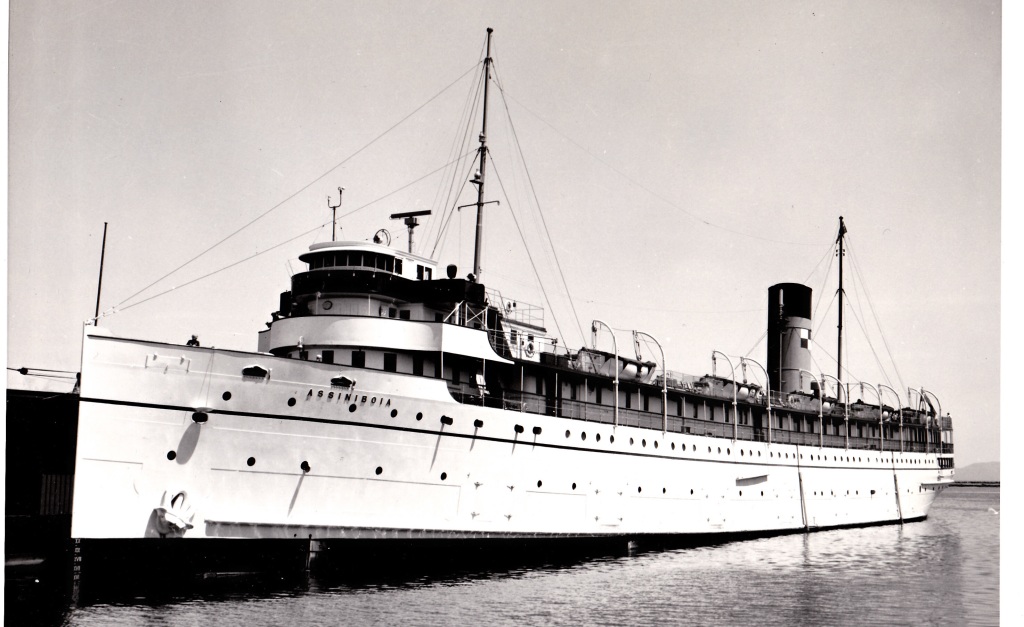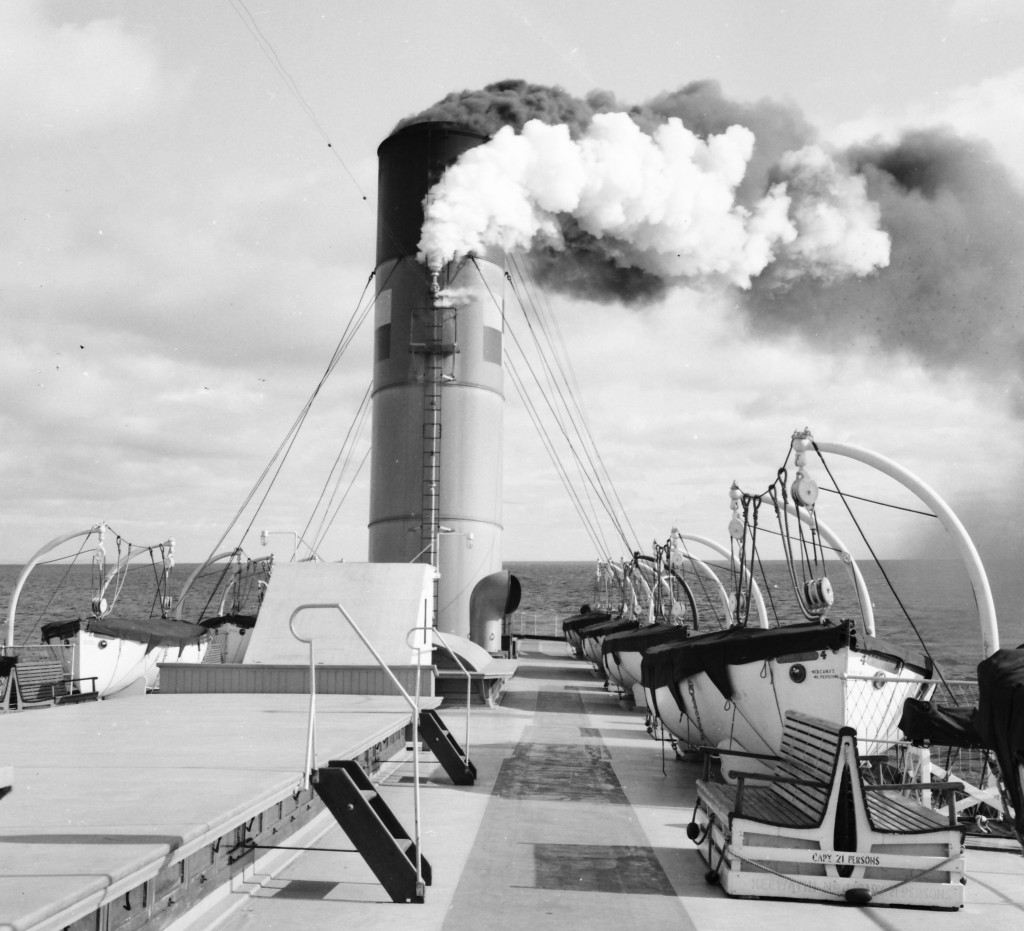Alan Howard, a friendly and loquatious marine enthusiast of Toronto, knew all about the Canadian Pacific white fleet that steamed weekly between Port McNicoll and the Lakehead. In the early Sixties, he and other steam buffs had taken the trip on the almost-twins Keewatin and Assiniboia, as they correctly guessed that the service would soon cease and the ships be retired.

On these trips Alan would tape record the steam whistles of passing vessels as well as the CP twins themselves. By 1964 he had quite a collection and thought there would be historic value in producing an LP recording of them. He visualized the album cover being a colour photo of Keewatin‘s white steam blasting against a background of black coal smoke from her stack, under a bright blue autumn sky.
Knowing I was living in Midland and was a fellow ship watcher and photographer, he asked if I wanted to do a trip with him and try for the cover photo. Would I? Do fish swim? Mind you, I would have to pay my own way, but such opportunities don’t pop up often so a bit of debt would be worth it.
Our trip would be in October, near the close of CP’s shipping season. We boarded the Kee at Port McNicoll around mid-day. Discovering we were the only passengers for the up-bound trip, we settled down for a leisurely crossing of Georgian Bay. Alan knew the pulse of the ship, where we could go without getting in the way and when we should avoid being a nuisance. He had learned that years earlier when he was general manager of the Lake Ontario passenger steamer Cayuga.

On previous trips Alan had persuaded Capt. Alex Campbell and Chief Engineer Gordon Gervais to allow him almost unlimited accesss to the wheelhouse and engine room. As we steamed past Giant’s Tomb and then Hope Islands, we contented ourselves with exploring the main decks, meeting the crew and enjoying a magnificent dinner in the wood panelled dining room, with views of dusk settling across the gently ruffled surface of Georgian Bay. It was like stepping back in time to an era of elegant lake travel from the 1920s and before, with Keewatin as our private yacht.
I didn’t want to climb into my berth that night. After dark I wanted to experience the open lake and watch the lighthouses pass by. Until then they simply had been names on the chart, but now I could actually see them across the dark waters for myself.
We awoke next morning to the sound of ship’s whistles all around us. Grabbing the tape recorder, we hustled up to the bridge as the ship crept through thick fog on the St. Mary’s River. Although marine radio was mandatory on Lakers by then, fog signals were also required (and still are) particularly in congested waterways.
As booming whistles and blaring horns bounced through the murk around us, Alan was ecstatic, his microphone aimed at every signal he could catch. Eventually the fog lifted and we passed through the Sault Ste. Marie locks just after breakfast.
With the captain’s permission, we decided the bridge outside the wheelhouse was the best place from which to record and photograph. Equally important to us, however, it was a chance to simply hang out with the crew. Alan could spend hours sharing stories and experiences especially with people aboard ship, and as a listener I soaked it all up.
On Keewatin he had a competitor. Chief Engineer Gervais, with a twinkle in his eye and a finely tuned sense of humour, could almost match Alan story for story. When he was off duty, the Chief would climb to the bridge to see how our project was coming along and have a good chat. The two of them together kept the men in the wheelhouse entertained.

The Chief was from Victoria Harbour, next door to Port McNicoll, and his wife was the local correspondent for the Free Press so I would see him from time to time in the years that followed. When the Kee retired I believe he did too. With his pipe in his teeth, his cap at a jaunty angle and a grin on his face, the Chief epitomized the real steamship man of that era.
Much less garrulous was Capt. Campbell. Though always polite and easy going, the Scottish born skipper wasn’t comfortable chatting up passengers, unlike his counterpart Capt. Ernest Ridd of the Assiniboia who apparently greatly enjoyed being host at his ship’s Captain’s Table.
Clearing Whitefish Bay, past the Sault, Keewatin turned her bow northwest across the vast expanse of Lake Superior. The sun beamed upon us from perfectly blue skies, the wind was brisk but not unbearable from the open lake where the ship traffic fanned out in different directions, and eventually we had our part of the inland sea to ourselves.

Hour after hour in that magnificent autumn weather we steamed along. Activity on the upper deck slowed to a regular routine. It was a good time to try and get our cover shot.
Alan’s vision of Keewatin‘s stack belching black coal smoke and white whistle steam against a backdrop of blue sky and water would never be more achieveable than that afternoon. We alerted the Chief to get lots of thick smoke ready. Then, stationing ourselves behind the wheelhouse, we would signal the officer inside to pull the whistle cord and I would snap away.
I was using a borrowed Rolleiflex camera with colour slide film as we were serious about getting quality images from which colour separations for printing could be made easily when the time came. As the sun moved around to the southwest to light that side of the ship, we spent the better part of the afternoon snapping that picture.
We finally called a halt to the photography. I’m sure everyone aboard sighed with relief as whistle-free silence descended. All that could be heard was the wind in the rigging and the waves breaking along the ship’s sides.

After another fine dinner and bedtime snack later, we turned in and awoke next morning tied up beside a warehouse in Fort William. Alan and I rented a car and spent the day exploring the Lakehead waterfront, returning to the ship next morning.
She was still being loaded with bagged freight on pallets, and this time several passengers with cars came aboard. The Kee was no longer our private yacht.
With so few passengers, the steward’s crew began closing the ship’s cabins. Bedding and linens were removed for winter storage. Cabins were thoroughly cleaned, and things generally were shut down for another season.
As we came down the Sault locks, Capt. Campbell revealed his seamanship skill by turning the ship 180 degrees in the busy and fast-flowing St. Mary’s River, to face upstream so we could stop briefly on the Canadian side to let passengers off. A boom was swung out and an agile young crewman Wayne Garrett was swung out and down to the dock to take the ship’s lines.
Our last evening was spent cruising down the river. The radio told us a freighter had grounded in Detour Passage. As we passed, there was just enough daylight to see the ship in the distance. Before turning in that night I went out on deck to see if the light on Great Duck Island was visible. Frank and Juanita Rourke of Midland were lightkeepers there then. Juanita’s column Up The Shore was a popular feature in the Free Press for years.
I’m sure it was The Ducks light I saw so I gave it a silent salute. A nice conclusion to a memorable experience I will never be able to repeat.
A sad ending to this story is that Alan Howard’s whistle project never came about. As curator of Toronto’s marine museum, he had saved a number of steam whistles there and would blow them for visitors, much muted, using a reversed vacuum cleaner. The city moved and then closed the museum, and the artifacts have been in storage ever since. Meanwhile, Alan passed away and eventually his widow did too, and all the material for the recording disappeared.
Wouldn’t it be good if it was found, and someone as keen as Alan Howard completed the project? I can only hope…
Footnote – This was Keewatin’s second last year on that run. At the age of 58 she and Assiniboia were too old to meet modern safety standards. Assiniboia eventually was sold to become a union’s shoreside training vessel but sadly she burned at Camden, New Jersey, before that could happen and she was scrapped. Keewatin was luckier. She was towed to Holland, Michigan, where she became a marine museum and was carefully preserved. In 2012 she was returned to Port McNicoll where for ten years she was meticulously maintained by Friends of Keewatin until 2023 when she was donated to the Maritime Museum of the Great Lakes at Kingston, ON, for permanent display.


